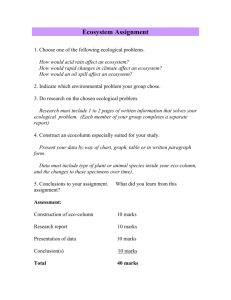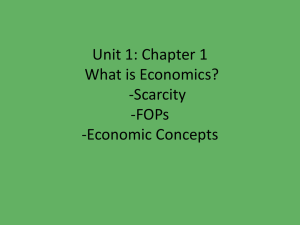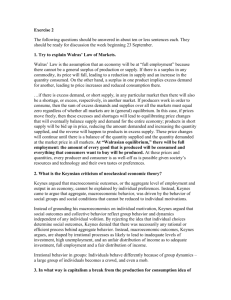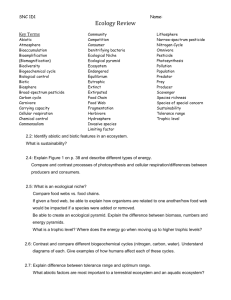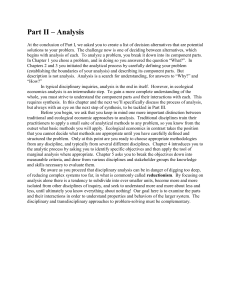Grp4-EmptyVsFullWorld
advertisement
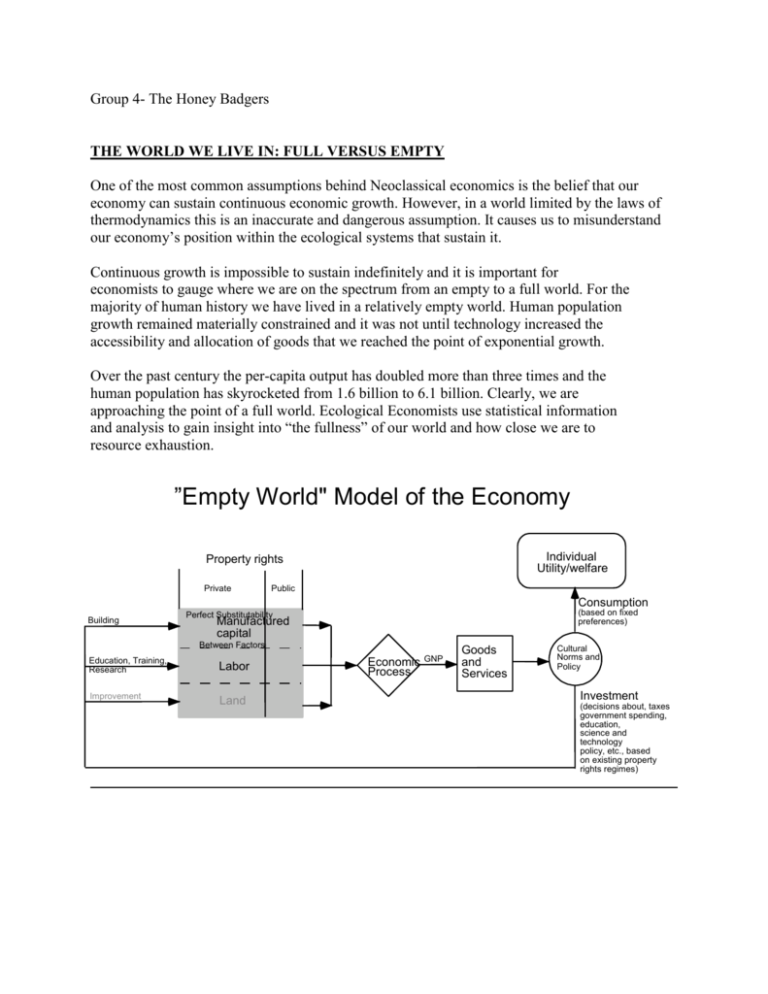
Group 4- The Honey Badgers THE WORLD WE LIVE IN: FULL VERSUS EMPTY One of the most common assumptions behind Neoclassical economics is the belief that our economy can sustain continuous economic growth. However, in a world limited by the laws of thermodynamics this is an inaccurate and dangerous assumption. It causes us to misunderstand our economy’s position within the ecological systems that sustain it. Continuous growth is impossible to sustain indefinitely and it is important for economists to gauge where we are on the spectrum from an empty to a full world. For the majority of human history we have lived in a relatively empty world. Human population growth remained materially constrained and it was not until technology increased the accessibility and allocation of goods that we reached the point of exponential growth. Over the past century the per-capita output has doubled more than three times and the human population has skyrocketed from 1.6 billion to 6.1 billion. Clearly, we are approaching the point of a full world. Ecological Economists use statistical information and analysis to gain insight into “the fullness” of our world and how close we are to resource exhaustion. ”Empty World" Model of the Economy Individual Utility/welfare Property rights Private Public Consumption Building (based on fixed preferences) Perfect Substitutability Manufactured capital Between Factors Education, Training, Research Labor Improvement Land Economic Process GNP Goods and Services Cultural Norms and Policy Investment (decisions about, taxes government spending, education, science and technology policy, etc., based on existing property rights regimes) “Full World” Model of the Ecological Economic System positive impacts on human capital capacity Well Being (Individual and Community) being, doing, relating Complex property rights regimes Individual Solar Energy Restoration, Conservation Education, training, research. Institutional rules, norms, etc. Building Common having, being Ecological services/ amenities doing, relating - having, - being Public Between Capital Forms Limited Substitutability having Consumption (based on changing, adapting preferences) Wastes Natural Capital Human Capital SocialCapital Economic GNP Production Process Goods and Services Evolving Cultural Norms and Policy Investment (decisions about, taxes community spending, education, science and technology policy, etc., based on complex property rights regimes) Manufactured Capital negative impacts on all forms of capital Materially closed earth system Waste heat From: Costanza, R., J. C. Cumberland, H. E. Daly, R. Goodland, and R. Norgaard. 1997. An Introduction to Ecological Economics. St. Lucie Press, Boca Raton, 275 pp. Objective1: Determine how the economy is a subset of the ecosystem. In the views of Neoclassical economics, the environment is a subset of the economy. It focuses on the circular flow and linear throughput which focus solely on the system of supply and demand. The laws of thermodynamics, when applied to neoclassical economic theories of growth, proves that in our closed earth system the supply of raw material and the accumulation of waste can not be carried out indefinitely. Thus we turn to the more appropriate view of the economy as a subset of the ecosystem. In this view there is a limit to the services nature can provide in terms of natural capital and waste absorption. The following activities have been designed to further explain this idea. Activities: A. Use these provided PowerPoint slides on micro and macro economics to gain an understanding of how the economy functions as a subset of the ecosystem. These slides are an introduction to the ideas of Marginal Cost vs. Marginal Benefit as well as efficient allocation. Read Environmental Economics: The Essentials from The Environmental Literacy Council. Chapter 10 will explain in depth how marginal cost and marginal benefit relate to the ecological economic view. B. Design a survey to test whether or not your peers believe the ecosystem is a subset of the economy or vice a versa. Clearly you can’t just ask that. The goal is the gain knowledge on consumption and the relative size of the economy verse the ecosystem. Here are some questions you might want to ask: Do you believe the economy has infinite space to grow? Are there limits to economic growth and what might they be? What is the connection between the natural resource bases (the biosphere/or individual ecosystems) and the economy? How does the economy interact with the ecosystem? Can you name a product that does NOT come from a natural resource? Are all resources finite (or are some infinite)? Compile the results of the survey based on similar responses. Present this data in a visually accessible way (i.e. Graphs, tables, charts.) C. Write a letter to your senator or congress representative. This requires a little bit of research into a natural resource or economic issue of your region. Use this website to look up contact information- https://forms.house.gov/wyr/welcome.shtml . Be sure to make practical policy recommendations in a manner that shows how the economy is restricted by growth of biophysical laws. The idea is to gain an understanding of the connection between environmental and economic issues of study and practical policy solutions in a real world scenario. Click here to view a standard format for a letter. Objective 2: Understanding Peak Oil Today 85% of the world’s energy needs comes from natural fuels, and the demand for natural fuels will only grow worldwide as India and China gain more wealth and increase consumption. Alarmingly, some scientists agree that we have used up over one half of the earth’s readily available natural gas reserves. There are several different substitutes for natural fuels, but none that can readily meet the demands of the world’s energy needs. We need to slow down our consumption of natural fuels before we use up all our reserves, unlimited growth forever is not a possibility. We are rapidly draining the Earth of its available energy. Assessing when and if we have reached Peak oil is a difficult task that economists have been struggling with for decades. Geologist, M. King Hubbert, created a theory for estimating future oil production in 1954, he predicted that peak oil production in the US would occur from 1967-1971. His theories have held up remarkably well as we reached peak production in 1970. Using his theories geologists today believe worldwide oil production will peak between 2003 and 2020, with many believing peak oil production has already occurred. Many organizations have an interest in saying that there are more available reserves than there may be, leading to an array of different estimates, many having a questionable validity. Due to massive subsidies the price of oil per barrel has remained nearly the same from 1869 to present day, even though we have more demand and fewer oil reserves than today. This reflects one of the biggest difficulties in assessing the “fullness” of our world. Markets do not always reflect the scarcity of the resource leading people to believe that it is in far greater abundance than it actually is. So what does this mean to you? We have to minimize the amount of energy we use, so that we have more to meet the needs of future generations. We all needlessly waste energy from one time to another. How can you decrease the amount of energy you use? Activity 2: Understanding Peak Oil A. Watch the following video clip on an introduction to the issue of peak oilhttp://www.youtube.com/watch?v=Ulxe1ie-vEY B. Make a comprehensive list of things that come from oil, and then answer the following questions; How many of those things end up as waste? How much can be reused? Recycled? What are the alternatives and what are the implications of implementation? What are the barriers and challenges associated with living in a post-peak oil world and how can they be overcome? Are there any benefits to living in a world that is independent of oil? C. Try reducing your reliance on oil, and then do a free write on how you achieved this. For example use public transportation instead of driving your car, and then write a paragraph on your experience. Objective 3: An introduction to optimal scale. Neoclassical microeconomic theory teaches us that rational self-interested people will continue to consume a good or service until the marginal costs are equal to the marginal benefits (see Figure 1). In other words, the benefits or costs associated with consuming one additional unit of that good or service will eventually become equal and the person will stop consuming that good or service. This is a function of decreasing marginal benefits. For example, consuming a second slice of pizza is less satisfying than the first, just as the third is less satisfying than the second and so on. When marginal benefits equal marginal costs, optimal scale is reached. Neoclassical macroeconomics, however, has ignored the optimal scale principle, and many economists have the explicit goal of unending macroeconomic growth. Ecological economics, by contrast, realizes that there are biophysical limits to growth. Furthermore, continued growth has costs of its own. Further production creates more costs like pollution and reduced resources, which society as a whole pays for in a sense. Growth beyond this point is uneconomic, that is the costs outweigh the benefits. Figure 1. Optimal scale, when marginal costs equal marginal benefits (Q*). Activity 3: Understanding optimal scale Take a quick survey to determine your ecological footprint at www.earthday.net. Develop some practical steps you and your friends can take to reduce the size of your ecological footprint. And see why more is not always better. (See Growth and Development Module) Submit as Proof of Learning - Compiled data from peer survey - Letter to your representative - List and questions from activity 2b - Write a one page free write reflecting the Ecological Footprint Survey - what did you get out of it and how did that exercise change your mind? Or how did it not? Do you think the responses received were an artifact of the questions asked, or did they reveal what you were looking for? Quiz on Full World vs. Empty World View Definitions [2 points each] Write a short definition, in your own words, describing the terms listed below. 1. Optimal Scale 2. Marginal Cost 3. Marginal Benefit Label [2 points each] Fill in the blanks with words from the word bank. Word Bank - Full World View - Empty World View - Economy (2) - Ecosystem (2) Short Answer [5 points each] 1. Explain what causes the leveling out in The Hubbert Curve from 1970 to 1975? 2. Why is it better to view the economy as a part of the ecosystem? 3. How can the idea of the economy as a subset of the ecosystem be applied directly to the idea of peak oil?


